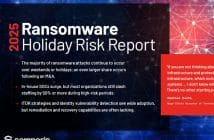
List Shares Top Attack Payloads and Malware Wreaking Havoc this Year
Webroot highlights the top cyberattacks of 2018 in its latest Nastiest Malware list, which showcases the malware and attack payloads that have been most detrimental to organisations and consumers alike. With the threat landscape constantly evolving, the need for cybersecurity education and tools to prevent attacks has never been more vital.
Explore the Nastiest Malware of 2018
Nastiest Malware & Payloads in 2018:
Botnets & Banking Trojans – Botnets and banking Trojans are the most commonly seen type of malware, with Emotet being the most prevalent and persistent seen to date.
Three Nastiest:
- Emotet is this year’s nastiest botnet that delivers banking Trojans. It aspires to increase the number of zombies in its spam botnet, with a concentration on credential gathering. Threat actors have recently developed a universal plug and play (UPnP) module that allows Emotet to turn victims’ routers into potential proxy nodes for their command-and-control infrastructure.
- Trickbot follows a similar attack plan, but contains additional modules (with more added each day) and has even been seen dropping ransomware. Imagine all of the machines in your network being encrypted at once!
- Zeus Panda has similar functionality to Trickbot, but has more interesting distribution methods including macro-enabled Word documents, exploit kits and even compromised remote monitoring and management services.
Cryptomining & Cryptojacking – Criminals are quickly moving to cryptomining and cryptojacking for faster, less risky ways of netting cryptocurrency. However, what some may call a victimless crime has a significant impact for businesses and consumers alike.
Three Nastiest:
- GhostMiner’s distribution method is the scariest part for its victims because they don’t know its entry point, similar to a scary movie where you know someone’s in the house but you don’t know where. GhostMiner is most commonly seen being distributed via an exploit in Oracle WebLogic (CVE-2018-2628).
- WannaMine’s Windows management instrumentation (WMI) persistence technique is extremely nasty, allowing it to remain stealthy and difficult to find and remove.
- Coinhive, initially innocent, was quickly added to the standard toolkit for attackers compromising websites. Even legitimate website owners are using Coinhive without knowing the impact it will have on their visitors. If your computer processing power (CPU) spikes to 100 percent when simply visiting a website, it might be Coinhive.
Ransomware – Ransomware has taken a backseat to the top threats in 2018 due to the rise of cryptomining. However, ransomware has become a more targeted business model for cybercriminals, with unsecured remote desktop protocol (RDP) connections becoming the focal point of weakness in organisations and a favourite port of entry for ransomware campaigns.
Three Nastiest:
- Crysis/Dharma goes hand in hand with the term “compromised RDP.” This ransomware has been evolving to remain one of the top dogs of the ransomware as a service (RaaS) world and specifically targets the RDP vector. System administrators consistently return to work after a weekend to find one or more of their machines encrypted, usually without knowing the source.
- GandCrab is yet another RaaS. It is especially nasty, as it is distributed via malspam campaigns, exploit kits, and RDP. Another interesting fact is that it uses the .bit TLD (top level domain), not sanctioned by ICANN, providing an added level of secrecy.
- SamSam, initially distributed via a JBoss exploit, soon turned to RDP and is now bringing down entire cities (or portions of them at least). You’ve likely seen these attacks in the news for taking down the city of Atlanta or the Colorado Department of Transportation.
Key Quote:
Tyler Moffitt, Senior Threat Research Analyst, Webroot
“This year, we’ve seen cyberattacks changing faster than ever, evading traditional defenses and wreaking havoc on businesses and everyday internet users alike. From gaping security holes, such as unsecured RDP, to tried-and-true tactics like phishing and exploits, to stealing crypto in the form of CPU power, cybercriminals are exploiting vulnerabilities in increasingly malicious ways. Businesses and individuals must be vigilant, stay informed, and focus on improving their overall cyber hygiene to avoid the devastating effects of these attacks.”
Additional Resources
- Explore the full list of Nastiest Malware on the Webroot Community
- Join the Webinar, The Nastiest Malware of 2018 for SMBs
- Learn more via Webroot’s Malware Manifesto
About Webroot
Webroot was the first to harness the cloud and artificial intelligence to protect businesses and individuals against cyber threats. We provide the number one security solution for managed service providers and small businesses, who rely on Webroot for endpoint protection, network protection, and security awareness training. Webroot BrightCloud® Threat Intelligence Services are used by market leading companies like Cisco, F5 Networks, Citrix, Aruba, Palo Alto Networks, A10 Networks, and more. Leveraging the power of machine learning to protect millions of businesses and individuals, Webroot secures the connected world. Headquartered in Colorado, Webroot operates globally across North America, Europe, and Asia. Discover Smarter Cybersecurity® solutions at webroot.com.





